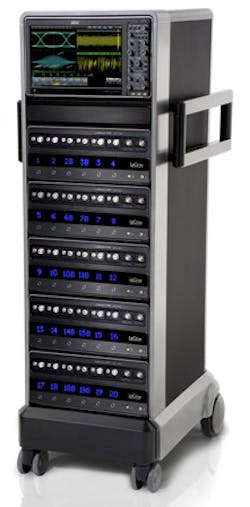LeCroy boosts oscilloscope bandwidth to 65 GHz
April 25, 2012
3 min read
A source at LeCroy Corp. asserts that the technology improvement that enabled the company to announce in January that its LabMaster 10 Zi real-time oscilloscope platform will soon support 60-GHz bandwidth will support 65 GHz as well – and 100 GHz of bandwidth at some point next year. Such bandwidth levels will prove particularly useful for engineers working on high-speed optical transmission using phase-based optical modulation formats and coherent detection. LeCroy announced yesterday that it will release an acquisition module for the LabMaster 10 Zi that will offer 65 GHz on two channels and 36 GHz on four channels. According to Ken Johnson, director of marketing at LeCroy, the company originally had hedged its bets on the performance of the 36-GHz 8HP SiGe chipsets that help enable its originally announced bandwidth upgrade. Now that the company can confirm the chipsets perform as expected, LeCroy has decided to accelerate its plans to offer full 65-GHz support by combining two 36-GHz channels via its Digital Bandwidth Interleave (DBI) technology. The combination of DBI and LeCroy’s ChannelSync architecture enables a fully configured LabMaster 10 Zi to deliver eighty 36-GHz/80-GS/s channels and up to forty 65-GHz/160-GS/s channels. The LabMaster 10 Zi platform consists of a Master Control Module and a number of Acquisition Modules. The Master Control Module contains the display, controls, ChannelSync architecture, and a server-class CPU; as the name implies, the Acquisition Modules contain the necessary signal acquisition capabilities. As many as 20 Acquisition Modules can be supported simultaneously, a significant improvement over the previous limit of five modules. Johnson says that, having promised 60-GHz support, LeCroy will also bring that level of capability to the market. The company plans to begin deliveries of Acquisition Modules featuring the 36-GHz chipset this summer. Modules that support 60-GHz bandwidth will likely appear slightly ahead of the 65-GHz versions, Johnson predicted. As things stand now, the 65-GHz capabilities will be the highest available on the market for a real-time oscilloscope. Agilent recently announced 62.5-GHz bandwidth support (see “Agilent ups bandwidth ante with Infiniium 90000 Q-Series real-time oscilloscopes”), which had trumped LeCroy’s previous 60-GHz announcement. The DBI technology also paves the way to 100-GHz bandwidth support, by interleaving three 36-GHz channels, Johnson continues. LeCroy plans to release modules with single-channel 100-GHz capability at some point in 2013, he says. In addition to the bandwidth upgrade, LeCroy also has revealed plans to offer a 28-Gbps serial pattern trigger, which will follow on the 14.1-Gbps trigger that will begin deliveries this July. The 28-Gbps version should be available by the end of this year, Johnson says. For more information on lab test equipment and suppliers, visit the Lightwave Buyers Guide.
About the Author
Stephen Hardy
Editorial Director and Associate Publisher
Stephen Hardy has covered fiber optics for more than 15 years, and communications and technology for more than 30 years. He is responsible for establishing and executing Lightwave's editorial strategy across its digital magazine, website, newsletters, research and other information products. He has won multiple awards for his writing.
Contact Stephen to discuss:
- Contributing editorial material to the Web site or digital magazine
- The direction of a digital magazine issue, staff-written article, or event
- Lightwave editorial attendance at industry events
- Arranging a visit to Lightwave's offices
- Coverage of announcements
- General questions of an editorial nature
Sign up for our eNewsletters
Get the latest news and updates

